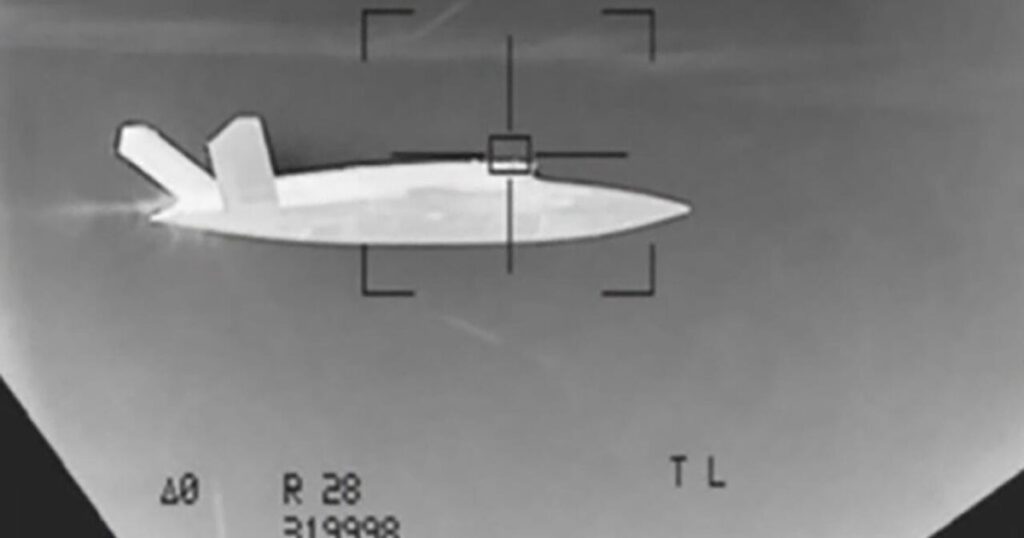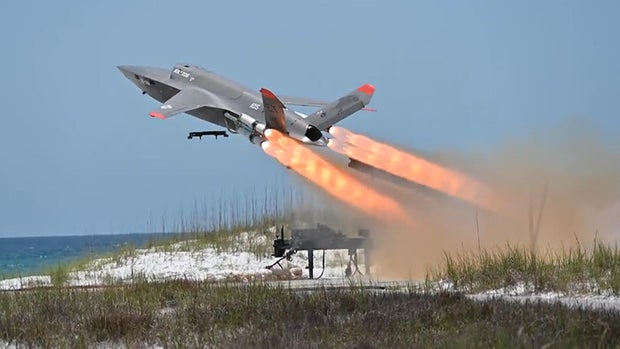At Eglin Air Force Base in Florida, a test bed for a new kind of air force, Major Trent McMullen is a fighter pilot learning to fly alongside the XQ-58, a drone piloted by artificial intelligence. Think of this as “Top Gun AI.”
“I’ve flown safety chase on it for several missions, messaging back and forth with the autonomy on board,” said McMullen.
Maneuvering alongside an AI-piloted drone, he said, takes a bit of getting used to: “As humans, we fly very smooth, but it can roll and fly a little bit snappier than maybe a human pilot would,” McMullen acknowledged. “It could be a little bit rougher a ride, but there’s no human on board.”
Artificial intelligence is on board, and now it is learning how to fight.
McMullen said the tasks assigned to AI might be to intercept an adversary aircraft: “So, we’ve been able to give it some of the basic blocking and tackling of air combat that we as human pilots also train on when we’re first learning how to fly,” he said.
CBS News
The XQ-58 blasts off like a rocket, but a full-scale model took off from a runway for the first time in August.
General Adrian Spain, head of Air Combat Command, is drawing up plans for operating AI-piloted drones alongside manned aircraft. “You’ve told them to go out in front and to execute an attack on a complex set of targets, and they will do that,” Spain said.
He says AI drones are capable of doing that today – and those drones could be armed with weapons.
An AI-piloted F-16 has already held its own in a limited dogfight against an experienced fighter pilot. At Top Gun AI, other F-16s are being rewired for more realistic combat. Those aircraft still have a cockpit, and a pilot, who can engage the plug-and-play AI system, and then remain on board as a safety pilot.
Pentagon
“So, once the AI goes on, the hands come off?” I asked.
“Yep, they’ll be monitoring the system and ready to take over at a moment’s notice,” McMullen said. “But we’ll also have real live aircraft out there for it to fight against. Those jets will be piloted by real fighter pilots trying their best to outsmart the AI.”
So, are we witnessing a revolution?
“If we continue down this path, it has the potential to be a revolution,” said Spain.
“You actually can take more risk”
Retired Air Force Lt. Gen. Clint Hinote says it is a revolution born of necessity: “The Air Force was so good for so long that it didn’t need to change. Now it needs to change, and it’s trying to figure out how.”
Change because the Chinese air force, which recently showcased its newest jet fighters and its own AI drone, could be more than a match for the U.S. Air Force. According to Hinote, “If we have to fight China, we’re likely doing it in their front yard, and that means they can bring many, many more things to bear than we can, because it’s so far away. You’re having to achieve kill ratios of 10 to 1, 15 to 1, and 20 to 1 to even stay in the game.”
I asked, “How do these war games come out when American pilots are going up against 20 to 1 odds?”
“The war games don’t turn out very well,” Hinote replied. “We lose.”
The Air Force is counting on AI drones to even the odds, by bringing to an aircraft what a human pilot doesn’t. McMullen said, “The big thing with artificial intelligence is the ability to handle large amounts of data. A human out in a complex air combat environment, there’s just no way to absorb all of it. Artificial intelligence might be able to take all of the data information, and then process that very quickly, and then make real-time decisions.”
AI drones will be about half the length of a manned jet fighter, and one-quarter the cost – $20 to 30 million each. Hinote said, “You could buy more airplanes, put them in the field, and still not break the bank. The key would be that you don’t have to bring the human operator home; you actually can take more risk.”
Spain says the Air Force expects to have 150 AI-piloted aircraft by the end of the decade, and eventually up to 1,000.
I asked, “These drones aren’t just going to sit in a hangar waiting for war with China. What are they going to do in peacetime?”
“It’s pretty wide open,” Spain replied.
“Could you send up AI drones to intercept those Russian bombers that come down off the coast of Alaska?”
“Yes, you could do that,” he said.
Those intercepts can turn nasty in an instant. Last year a Russian fighter rocked an American F-16, so AI drones would have to be prepared to shoot.
So, is AI going to be making life-or-death decisions? “Absolutely not,” said Spain. “Absolutely not. The human who’s controlling the AI will make the life-and-death decisions.”
At least for now.
Making life-or-death decisions
Hinote said, “Increasingly militaries around the world, including the United States military, are going to be pressured to give the machines more leeway in making those life-or-death decisions.”
Including the capability to fire on their own? “The United States military is investing in the experimentation that you would need to be able to produce the types of platforms that could fire on their own if you gave them that option,” Hinote said.
If adversaries let AI make those decisions, what happens? “I think they do so at their own peril,” said Spain. “Because the AI can be fooled, the AI can be overwhelmed. It can give you false outcomes. We’ve seen that AI can hallucinate. So, it’s not a guarantee of success. What it guarantees is that it will do something quickly.”
“Don’t you at least have to give your pilots that option?” I asked.
“To go full autonomy and just let it go? I don’t think America is comfortable with that yet,” Spain replied. “I’m not saying that couldn’t be a future world that we live in where we trust it. But I don’t think we’re there right now, certainly, and certainly not to start. We have to build that trust over time.”
At Top Gun AI, pilots keep putting in the reps, test flight after test flight, simulation after simulation, to build that trust.
Asked whether he would rather go into combat with a human wingman or an AI wingman, McMullen replied, “When we’re talking about the threats of tomorrow, if I can send an uncrewed asset into a high-risk environment, I’d rather do that than send a human pilot.”
For more info:
Story produced by Mary Walsh. Editor: Carol Ross.
https://www.cbsnews.com/news/ai-in-the-military-testing-a-new-kind-of-air-force/



